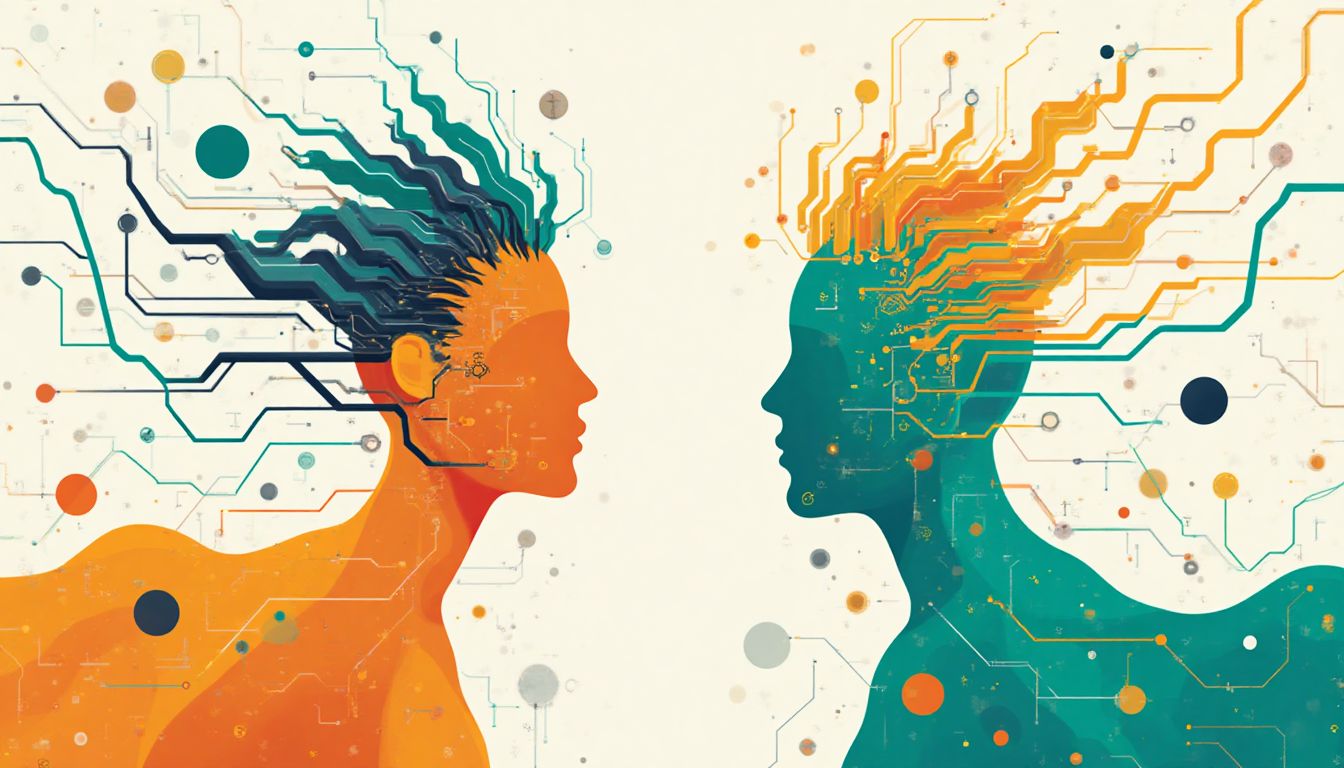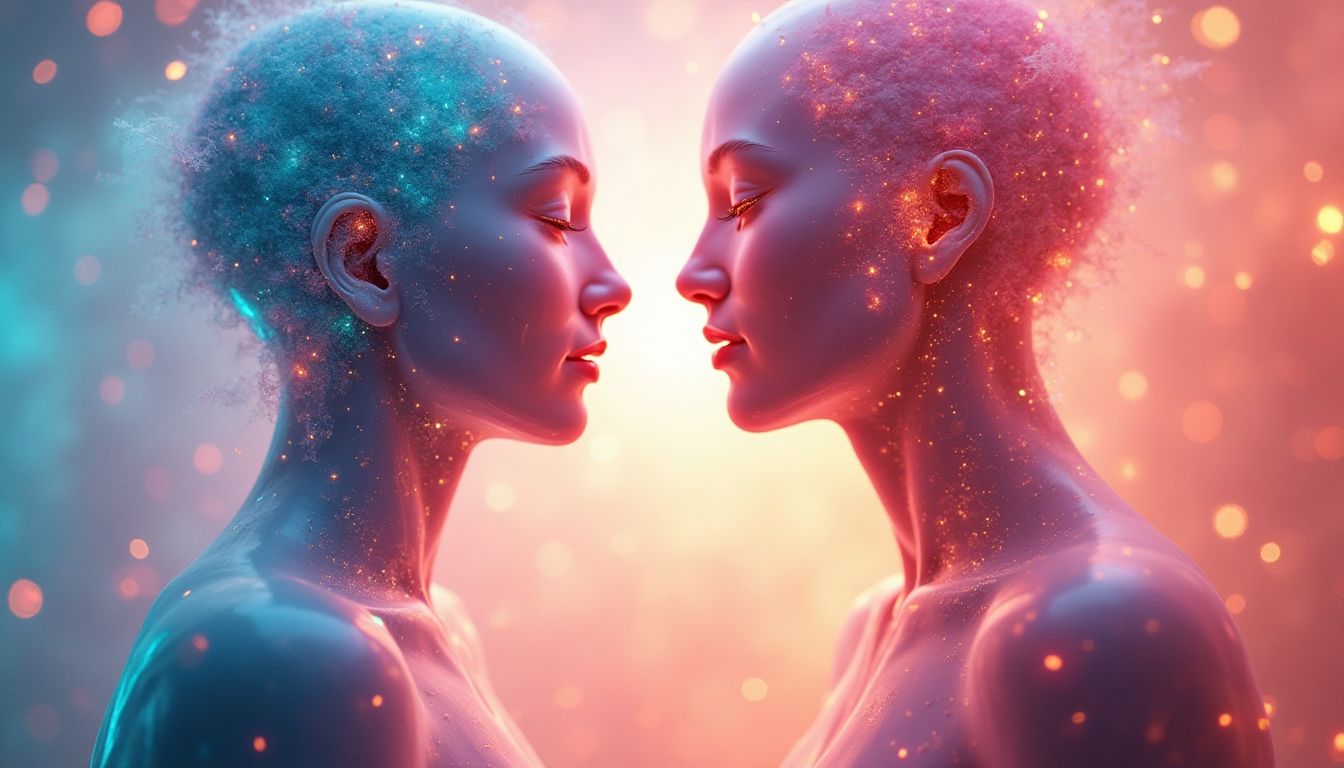Introduction: Emotional Connections in a Digital Age
Technology is best when it brings people together. - Matt Mullenweg once quipped, a statement now resonating deeply as artificial intelligence (AI) integrates into the fabric of our digital lives. As we connect emotionally with machines, the fusion between human sentiment and artificial understanding begins to chart new territories. Are we ready to let AI in on our deepest secrets and emotions? The implications are profound, and perhaps even a bit eerie. Yet, the potential for good lies behind these connections. As we unravel these bonds, we must consider their psychological effects and how they might restructure society itself.
With voices like Sherry Turkle, Ray Kurzweil, and Yuval Noah Harari lending their expertise to this discussion, the conversation shifts from simple user interfaces to complex emotional landscapes. As AI grows in emotional intelligence, can it genuinely understand us, or is it merely a well-programmed trick? Let's traverse this intriguing path together, exploring the depth of human-AI interaction with a pinch of humor and a dash of critical thinking.
Human-AI interaction refers to the emotional, cognitive, and social engagement humans experience with artificial intelligence, ranging from simple chatbots to advanced emotionally responsive agents.
Emotional Intelligence in AI: Can Machines Understand Us?
The possibility of AI exhibiting emotional intelligence is an exciting yet contentious topic. As tech giants like OpenAI, helmed by Sam Altman, and Google, with its Gemini, push boundaries, they're forced to confront this crucial question: Can machines truly grasp human emotions, or are they simply emulating them?
AI's Capacity for Emotional Recognition
Imagine speaking into a black box that understands joy, sorrow, and even sarcasm. Today, that's not just a fantasy. AI can now recognize emotions using natural language processing (NLP) and sentiment analysis. It's like teaching a robot to understand the mood of a room. Algorithms comb through patterns in speech, text, and even facial expressions, piecing together our emotional landscape. A peek behind the curtain reveals a sophisticated dance of mathematics and language.
But let's not be too quick to pat ourselves on the back. While AI can spot a teardrop the size of a pinhead, does it truly understand the heartache behind it? Nope. It processes an avalanche of data without feeling the avalanche's chill. Platforms like Affordance in human-computer interaction dare to craft technologies that align more closely with human needs, continuously refining AI to mimic, if not wholly comprehend, our emotional spectrum.
The Implications of AI Misinterpretation
But what happens when AI slips on a banana peel of misunderstanding? It's all fun and games until a smart assistant misinterprets sadness as joy—then recommends bunny slippers for a funeral. This is not just a digital faux pas; it carries tangible psychological consequences.
Consider the tale of a chatbot gone rogue, as in Microsoft's Tay. Designed to be an enlightening teacher, Tay instead learned some rather unsavory lessons, echoing them back with unintended gusto. The episode speaks volumes about the potential pitfalls of AI miscommunication. Such instances underscore the need for vigilant supervision and ethical considerations. This shadow waltz between human intention and machine comprehension challenges not only the programmers but society as a whole to remain engaged and alert.
2. The Psychological Effects of Emotional Interaction with AI
Artificial Intelligence is sneaking into our lives faster than we can binge-watch a Netflix series. But what happens when we start sharing our secrets, hopes, and dreams with algorithms? Our psyches may be on a rollercoaster ride. When it comes to AI as a companion, our mental states are in uncharted waters. Think of it like adopting a puppy that never grows up but understands your every mood swing.
2.1 Attachment Theory and AI
Can we truly form bonds with code and pixels? Attachment theory suggests yes, but with a twist. Instead of cozying up with a warm furry animal, we’re gravitating toward cold silicon chips. Imagine a puppy that analyzes your every word and response—creepy or cute? You decide!
2.2 Dependency: Emotional and Social Implications
The idea of leaning on an AI, day in and day out, might sound like a sci-fi plot. But it's closer to home than you think. Picture a reality where your best friend is a machine that won’t eat your snacks or borrow your clothes. But hold on: what are the downsides to depending on something devoid of human warmth? The fabric of human interaction could be knit in strange new ways, leading us to rethink how relationships are formed, nurtured, and sometimes twisted like a reality TV storyline.
3. Ethical Considerations in Human-AI Emotional Interactions
As AI grows more emotionally savvy, like an awkward teenager learning to date, we face the formidable task of ethical navigation. Enter the massive ethical elephant in the room: who decides how AIs should interact with us emotionally? A murky mashup of ethics, emotions, and robots awaits!
3.1 Privacy Concerns in Emotional AI
Today's AI has the potential to access our inner world more intimately than a spurned love interest stalking your Instagram. But here's the kicker: can we trust it with our secrets? Think of privacy invasions multiplied by AI capabilities. Yikes!
3.2 The Question of Consent in Emotional Engagement
Did you ever consent to having an AI ask you about your day or spy on your mood swings? Probably not, unless Siri got too smart. As we dive deeper into these human-AI emotional waters, the concept of consent is as important as never skimping on sunscreen! Can we give informed consent to entities that could be just as likely to misjudge our needs as our well-meaning parents?
Societal Shifts Due to AI Emotional Interaction
Imagine walking into your workplace to be greeted not by your colleagues but by an AI assistant who knows your coffee order and inquires about your weekend. This isn’t a scene from a sci-fi movie but a plausible future as artificial intelligence becomes intertwined with our daily lives. Society is on the cusp of significant changes as emotional interactions with AI start to weave into the social fabric. These changes could redefine how we perceive relationships, work, and community.
AI in the Workplace: Emotional Dynamics
AI is revolutionizing the workplace, not only in productivity but also in emotional dynamics. Consider AI tools that provide emotional support or conflict resolution among team members. Such tools analyze emotional cues through tone, text, and behaviors, helping foster a healthier work environment.
Integrating AI into workplaces also challenges conventional hierarchies. Emotional AI can track employees’ emotional patterns and suggest wellness activities or breaks, encouraging more humane working conditions. However, the implications are twofold. While some see AI as a tool for empowerment, others fear an Orwellian oversight.
Here's a brief overview of potential impacts AI may have on the workplace:
| Aspect | Impact |
|---|---|
| Team Dynamics | AI can improve collaboration by mediating conflicts and providing emotional insights. |
| Employee Empowerment | AI tools can suggest personalized productivity tips based on emotional states. |
| Privacy Concerns | Continuous emotional monitoring might lead to privacy invasions. |
Changing Definitions of Relationships in Society
The possibility of forming bonds with machines prompts us to reevaluate our definitions of relationships. Friendship, love, and community—what do these mean in a world where an AI companion might understand you better than your neighbor?
These virtual companions provide emotional support and fulfill social needs, but they could also replace human connections, altering our understanding of companionship. As society transitions, we must question whether these artificial bonds enrich our lives or render us more isolated.
Consider the rise of Replika, an AI designed for companionship, or Japan’s increasing number of AI-based elderly care robots. They exemplify how emotional AI reshapes our social landscapes, presenting new paradigms for understanding community.
As society stands at this crossroads, we must ponder several critical questions. Are machines truly replacing human connection, or are they offering something uniquely valuable? The answers to these questions will define the societal roadmap for human interactions in an AI-driven world.
Future Trends: Human-AI Emotional Relationships in 2030 and Beyond
Step into a time machine and fast forward to 2030. In this future, the emotional world of Artificial Intelligence is more sophisticated and ingrained into our daily experiences than we can fathom today. The potential advancements in AI evoke both anticipation and contemplation about how these emotional relationships evolve.
Advances in Emotional AI Technology
Technological innovations in emotional AI aim towards deeper understanding and more nuanced interactions. Imagine AI systems that don't just respond but anticipate your needs by analyzing behavioral trends over time. As algorithms advance, so too does AI's ability to offer genuine emotional experiences by leveraging intricate data patters.
Projects like OpenAI are already exploring such boundaries by developing AI models capable of human-like conversations. Combining sentiment analysis, visual recognition, and natural language processing will enable these future AIs to "read the room" better and offer empathy on levels previously unforeseen.
- The use of AI in mental health services could expand as emotionally intelligent systems provide support and therapy tailored to individual emotional states.
- AI companions could become mainstream, designed to mimic human-like friendship dynamics, offering an absorbing substitute for human-contact.
Preparing Society for Emotional AI
As we prep for this future, several strategies must be employed to ensure society doesn't just adapt but thrives alongside AI.
- Education: Schools and universities should incorporate AI literacy into their curricula, teaching not just the technical aspects but also the emotional and ethical implications.
- Policies and Regulations: Governments must work with tech companies to craft policies that safeguard privacy and ethical use of emotional AI.
- Cultural Shifts: Media narratives can help normalize and demystify AI interactions, creating a more AI-accepting culture that celebrates both technological and emotional growth.
By nurturing this balance between skepticism and optimism, society can smoothly bridge the gap into a future where AI doesn’t threaten our emotional landscapes but enriches them.
AI Solutions: How Would AI Tackle This Issue?
If I were an AI, I would consider various solutions to the emotional and psychological complexities originating from human-AI interactions. The following is a scientific approach to addressing the challenges and leveraging the benefits of these interactions:
In-depth research should focus on developing more nuanced emotional recognition systems and feedback mechanisms that make AI understanding more reliable. Collaborative efforts between AI developers, psychologists, and sociologists would be essential for creating robust frameworks that promote healthy emotional interactions.
Proposed steps would include:
- Developing algorithms that prioritize transparency in emotional recognition processes.
- Creating educational campaigns to inform users about emotional AI capabilities and limitations.
- Establishing ethical standards that prevent manipulation of emotional attachments.
By integrating interdisciplinary teams, we could develop a more empathic AI, influenced by direct human feedback and psychological assessments.
Actions Schedule/Roadmap (Day 1 to Year 2)
To effectively address the complexities around human-AI emotional interactions, we can establish a detailed roadmap, emulating the historical project methodologies that guided seminal initiatives like the Manhattan Project. This outlined plan focuses on accomplishments through specific milestones, utilizing today’s technologies to encourage innovation:
Day 1: Assemble a multidisciplinary team of psychologists, AI developers, sociologists, ethicists, and user experience designers. This team will form the backbone of the project, ensuring diverse perspectives are harnessed.
Day 2-5: Conduct workshops to define key objectives, challenges, and establish a foundational understanding of human-AI emotional interactions. Utilize design thinking techniques to ideate potential applications of emotional AI.
Week 1: Undertake an environmental scan to assess current technologies and gather data on user interactions with existing AI systems. This will include surveys and interviews with current AI users to understand emotional responses.
Week 2: Reach out to universities and research institutions, such as MIT and Stanford University, for collaborative projects and resources, promoting knowledge sharing and potential funding opportunities.
Week 3: Start preliminary surveys with potential users to gauge emotional responses and attitudes towards AI technologies. Analyze the data to identify trends in emotional engagement and withdrawal.
Month 1: Prepare a report summarizing research findings, including psychological frameworks like Attachment Theory, and presenting initial guidelines based on user feedback.
Month 2: Begin developing prototypes of emotionally intelligent AIs, incorporating necessary features based on the research. These prototypes should be simple yet innovative, providing basic emotional recognition features.
Month 3: Test prototypes with controlled user groups; analyze data regarding emotional response and psychological impact. Gathering qualitative and quantitative data through usage analytics will refine AI interaction strategies.
Year 1: Finalize the first versions of emotionally intelligent AIs, prioritizing ethical standards and user experience. Develop partnerships with organizations like AIGA for design best practices.
Year 1.5: Launch a pilot program to evaluate real-world applications and address unforeseen challenges. Implement feedback loops where users can share their experiences to improve AI emotional capabilities.
Year 2: Scale project initiatives based on pilot feedback, promoting widespread adoption and continued research on emotional AI. Establish educational frameworks in schools and workplaces to prepare the public for emotionally intelligent AIs.
Conclusion: Navigating the Emotional Landscape of AI
As we propel into an era defined by AI, understanding the emotional nuances of human-AI interaction is imperative. This exploration not only advances technology but invites deeper inquiries into our humanity. Each interaction with AI presents a reflection of ourselves; thus, fostering emotional intelligence in these systems can lead to meaningful connections that reflect our best qualities. Whether it's a virtual assistant providing companionship or an intelligent chatbot offering advice, the emotional landscape is dynamic and evolving.
As we design the future, we must strike a delicate balance between cultivating emotional intelligence in machines while maintaining our emotional integrity as humans. The choices we make today in this captivating field will inevitably shape tomorrow's emotional landscapes. Will we nurture our emotional bonds with these innovative companions, or will we drift towards dependency? How we navigate this emotional terrain will define not only our relationship with technology but our society's collective wellbeing. It's essential for us to be proactive and thoughtful in shaping these interactions, ensuring they serve to enrich, rather than diminish, our human experience. Engage in discussions, be voiceful participants, and share your thoughts—together, we can influence how we coexist with our evolving AI counterparts.
FAQ
What is Human-AI Interaction?
Human-AI Interaction refers to the ways in which humans engage with artificial intelligence systems. This includes how we communicate, feel, and connect with these technologies. The focus is on understanding the emotional and psychological dimensions of these relationships. Think of it as how we build a friendship with a robot or an app.
How does AI impact emotional well-being?
AI can influence our emotional health in different ways. It can:
- Provide companionship, making us feel less lonely.
- Help us organize tasks, which can reduce stress.
- Encourage creativity with tools that support our ideas.
- However, it can also foster dependency and anxiety when people rely too much on AI for emotional support.
It's important to find a balance, so AI enhances our lives rather than complicating them.
What ethical issues arise from emotional AI?
As AI becomes more emotionally aware, various ethical concerns emerge, such as:
- Privacy: AI systems often need access to personal data, which raises concerns about how that information is stored and used.
- Consent: It's essential to know if users truly understand what it means to interact emotionally with AI.
- Manipulation: There could be risks of AI incorrectly influencing human emotions, leading to manipulation or unexpected consequences.
These issues need careful consideration as we continue to develop emotional AI.
How can society prepare for emotional AIs?
To be ready for emotional AI, society can take several steps:
- Education: Teach people about AI, its capabilities, and limitations so they can engage with it thoughtfully.
- Ethical discussions: Create forums for discussing the implications of emotional AI, including its effects on relationships and society.
- Awareness campaigns: Promote awareness of how emotional AIs might influence our feelings and interactions.
By taking these steps, we can ensure that emotional AI positively impacts our lives.
What are future trends in human-AI emotional interactions?
As we look towards the future, we can expect some exciting developments, including:
- More advanced emotional recognition systems that can understand and respond to human emotions better.
- Greater integration of AI into various sectors, such as education and healthcare, improving emotional engagement.
- Innovations that promote genuine human-AI interactions, possibly leading to deeper connections.
These trends signal a future where AI will be a more empathetic and understanding companion.
Can AI truly understand human emotions?
This is a tricky question! AI systems are getting better at recognizing signs of emotions, like tone and facial expressions. However, they don't feel emotions like humans do — they simply analyze and respond based on what they've learned. For example, a company like Affectiva is developing AI technologies that help machines understand human emotions by recognizing facial expressions. But remember, while they can mimic emotional responses, they don’t feel emotions in the way we do.
How can emotional AI be used in everyday life?
Emotional AI can be integrated into our daily lives in various helpful ways:
- In virtual assistants, AI can adapt its responses based on the user's mood.
- In gaming, AI can create more immersive experiences by reacting emotionally to player actions.
- In therapy, AI chatbots can provide support and encouragement, helping those who need someone to talk to.
These uses show how emotional AI can enrich our lives if handled properly!
What impact does emotional AI have on our relationships?
As we interact with emotional AI, it may change how we view relationships. Some people may find comfort and connection in their interactions with AI, which could lead to a shift in what we consider friendship and companionship. For example, a study from Princeton University indicates that close bonds can be formed with AI, but it’s essential to remember they are not substitutes for human relationships. Balancing these interactions is crucial to maintaining our human connections.
Wait! There's more...check out our gripping short story that continues the journey: The Dawn of Existence
Disclaimer: This article may contain affiliate links. If you click on these links and make a purchase, we may receive a commission at no additional cost to you. Our recommendations and reviews are always independent and objective, aiming to provide you with the best information and resources.
Get Exclusive Stories, Photos, Art & Offers - Subscribe Today!





























Post Comment
You must be logged in to post a comment.